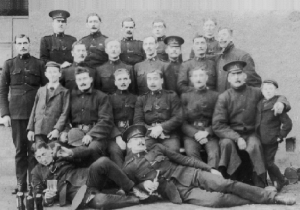Condemnation and support
Published in 1913, 20th Century Social Perspectives, 20th-century / Contemporary History, Artefacts, Features, Issue 4 (July-August 2013), Volume 21
Above: Some of the extra RIC constables brought in from counties Tipperary, Waterford, Carlow and Kilkenny relaxing and enjoying a beer. Back row (l–r), Constables Hobbs, Kennedy, Quirke, Gleeson and McAtarsney; second row, Constables McGosham, Moore, Gordon, Johnston, Donovan, Byrne and Keenan; third row, Constables O’Grady, Kelly, Carney, Lennane and Martin; reclining, Constables Glennon and Campbell. The two local boys are the Thomas brothers. (Information and photo supplied by Nicholas Furlong)
The lockout brought much hardship to families, affected trade and occupied both the infirmary and the court house. It therefore drew reactions from various and diverse groups. The GAA quickly showed their support for the locked-out men by staging challenge matches to raise funds. Even funds from the Leinster hurling final between Dublin and Kilkenny were donated. Wexford Corporation urged a settlement on both sides, as damages to property from rioting brought high repair costs. In addition, hundreds of workers were unable to pay their rent, denying the Corporation income. Many local shopkeepers and traders gave generous credit to locked-out families, while the Workers Aid Fund established by Robert Moran helped organise events to raise money. Local Catholic curate Fr Mark Byrne attempted to bring both groups together, but the 1871 papal encyclical Rerum Novarum allowed many clergy outside the town to viciously condemn the workers in Wexford. The pulpit was a formidable tool to which the workers had no right of reply. The tirades and rebukes of priests and bishops in local newspapers amplified Church criticism, and the moral authority of the Church influenced the reader. Arthur Griffith’s recently formed Sinn Féin party was divided on the issue, while the IPP leader John Redmond, MP for North Wexford between 1885 and 1891 and whose family estate was in the south of the county in Ballytrent, chose to ignore requests from the Irish Trade and Labour League to intervene to help find a settlement.
















